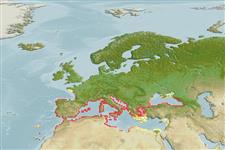Actinopterygii (ray-finned fishes) >
Perciformes (Perch-likes) >
Blenniidae (Combtooth blennies) > Salariinae
Etymology: Parablennius: Greek, para = the side of + Greek, blennios = mucus (Ref. 45335).
Environment / Climate / Range
Ecology
Marine; demersal; non-migratory; depth range 0 - 1 m. Subtropical, preferred ?; 50°N - 30°N, 18°W - 42°E
Eastern Atlantic: Loire, France to Morocco including the Mediterranean and Black Sea.
Size / Weight / Age
Maturity: Lm ? range ? - ? cm
Max length : 20.0 cm TL male/unsexed; (Ref. 3397); common length : 12.5 cm TL male/unsexed; (Ref. 3397)
Are residents in intertidal areas with homing behavior (Ref. 32612). They are found between pebbles or at margins of steep, filamentous algae-covered rocks exposed to sunlight. They make underwater 'flight' over long distances. Feed almost exclusively on algae (Ref. 205), favoring the algae Ulva (Ref. 94105). Spawns from May to July. Oviparous. Eggs are demersal and adhesive (Ref. 205), and are attached to the substrate via a filamentous, adhesive pad or pedestal (Ref. 94114). Larvae are planktonic, often found in shallow, coastal waters (Ref. 94114).
Life cycle and mating behavior
Maturity | Reproduction | Spawning | Eggs | Fecundity | Larvae
Oviparous, distinct pairing (Ref. 205).
Zander, C.D., 1986. Blenniidae. p. 1096-1112. In P.J.P. Whitehead, M.-L. Bauchot, J.-C. Hureau, J. Nielsen and E. Tortonese (eds.) Fishes of the North-eastern Atlantic and the Mediterranean, volume 3. UNESCO, Paris. (Ref. 5981)
IUCN Red List Status (Ref. 115185)
CITES (Ref. 94142)
Not Evaluated
Threat to humans
Harmless
Human uses
Fisheries: minor commercial; aquarium: commercial
More information
ReferencesAquacultureAquaculture profileStrainsGeneticsAllele frequenciesHeritabilityDiseasesProcessingMass conversion
Tools
Special reports
Download XML
Internet sources
